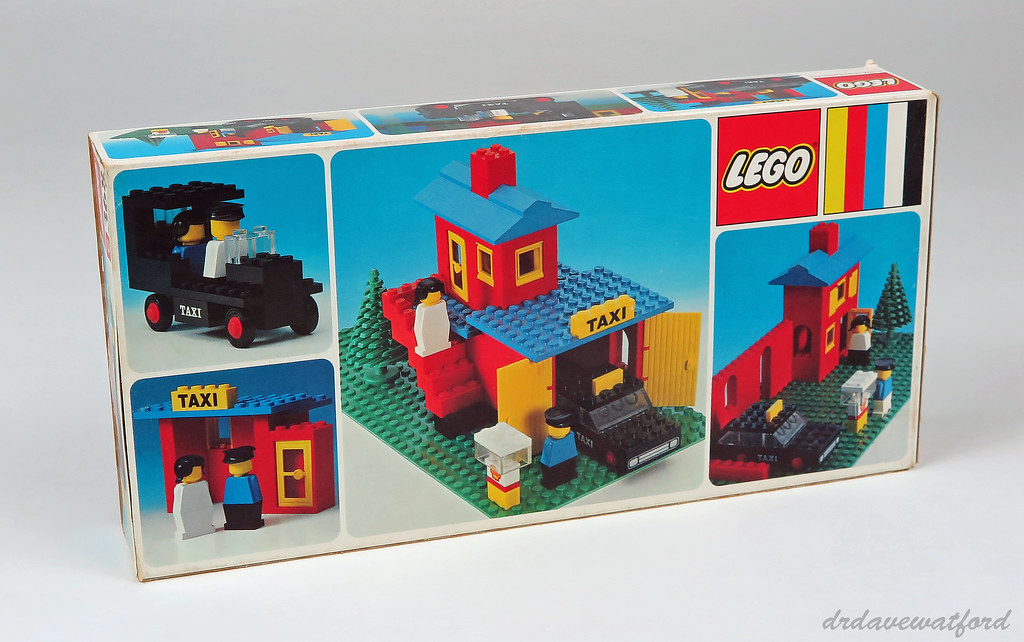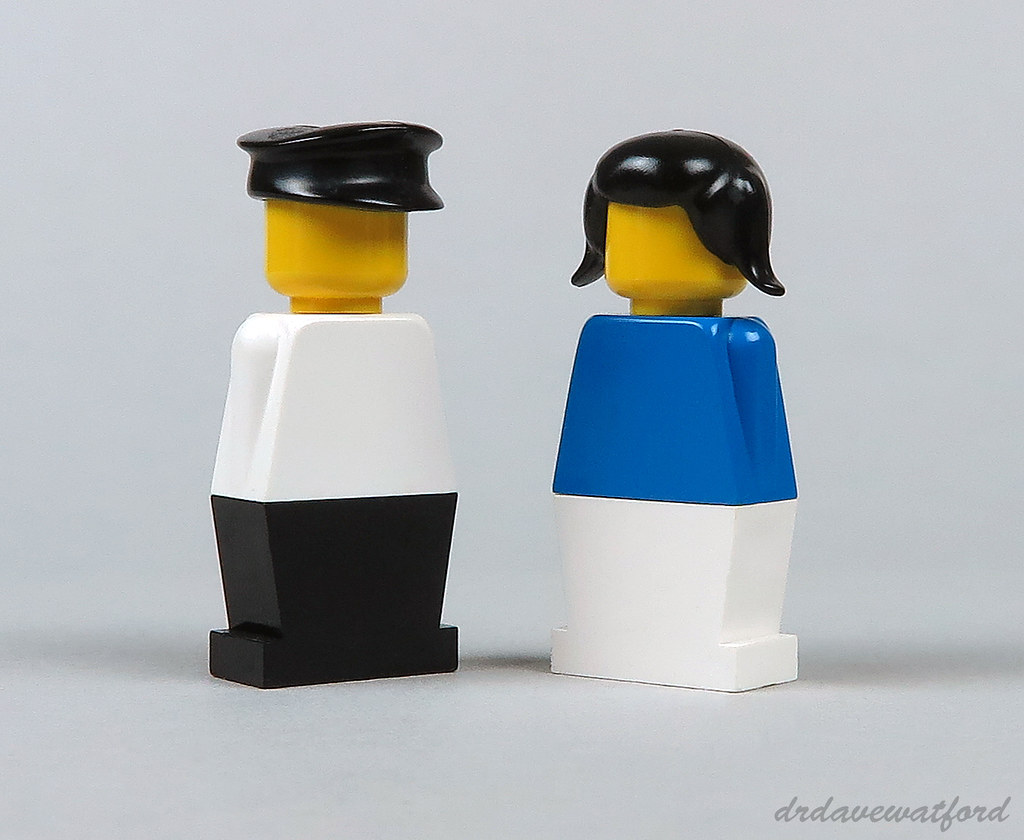Given everything that's going on in the world right now, I've felt in desperate need of some light relief to lift the spirits. One thing that works for me is to take solace in an old LEGO set and wallow in some much-needed nostalgia. My latest trip down memory lane was 368 Taxi Garage, released in 1976. I spotted my copy of the set perched atop of a bunch of other sets on a bookcase and I thought it would fit the bill nicely.
The front of the box is dominated by a simple image of the set contents assembled and ready to be played with, together with a 6+ age recommendation. The back of the box features a number of panels containing images of alternate builds including a small taxi stand, a vintage taxi and two quite respectable reimagined versions of the taxi garage. The alternate builds don't stop there, either - there's also a horse-drawn taxi carriage on one of the side panels of the box.
To open the box you just slide off the outer sleeve. This reveals a white inner tray containing the parts and an instruction sheet.
The building instructions are printed on a large double-sided sheet more than half a metre long and 27 cm wide. This folds down into a square measuring around 13.5 cm x 13.5 cm, and once folded the image above appears on the front 'cover', while the back 'cover' (below) showcases a selection of the alternate builds which adorn the box.
The set includes a pair of what LEGO have termed "stage extra" figures (below) which are I assume supposed to be a taxi driver and his female passenger. Figures like these were the precursors of modern minifigures and started to appear in sets in 1975. Unlike their modern counterparts they don't have moveable arms and legs, and there isn't any printing on their heads or torsos, although they did occasionally feature stickered torsos as you can see here. They were superseded by modern minifigures in 1978 so weren't produced for long, but they remain an interesting and important evolutionary step in the development of the minifigure. While the individual elements making up these particular figures could be found in numerous sets, this is the only set which included the taxi driver figure, while the female passenger only ever appeared in two sets in addition to this one.
According to Brickset 368 Taxi Garage contains 156 elements, although Bricklink reckons the part count is 144 plus an additional 8 elements for the figures. The garage itself is constructed on a green 16 x 32 baseplate with rounded corners which only ever appeared in two sets including this one. The set also includes a number of printed elements. The 1 x 4 yellow brick with black 'TAXI' print is unique to this set, as are a pair of black 2 x 3 bricks with white sans-serif 'TAXI' print; of note, a black 2 x 3 brick with white serif 'TAXI' print was produced in 1971 and can also only be found in one set, 605 Taxi. Other notable printed elements include a black 1 x 4 brick embossed with a chrome car grille print and a white 1 x 2 brick printed with the Shell logo.
I built the taxi first. In most respects it's identical to the vehicle in the 605 Taxi set but there are a couple of differences. Firstly, as mentioned above a different font is used for the 'TAXI' print on the side. More notably, however, the rear end has been redesigned; the older standalone taxi is just two studs long behind the rear wheels, but the newer taxi has been inexplicably lengthened by a stud and the rear looks dreadful. A yellow 1 x 2 tile is wedged between studs on the roof of the vehicle, indicating that the taxi is available for hire; this building technique wasn't uncommon back in the day but was later deemed "illegal" by LEGO as it places undue stress on the elements concerned.
By 1976 LEGO had stopped printing a dot pattern on baseplates (like you can see here, for instance) to guide placement of elements so the 16 x 32 baseplate supplied with this set is consequently unprinted. Construction of the taxi garage is predictably quick and straightforward, requiring only 12 steps on the instruction leaflet. As previously stated the yellow 1 x 4 brick with 'TAXI' print on the garage roof is exclusive to this set, while the pair of 1 x 4 x 6 yellow doors which enclose the garage appeared for the first time ever in this set before going on to appear in a further 9 sets between 1976 and 1990.
With the notable exception of the modular buildings, most buildings which appear in modern sets tend to be open at the back, ostensibly to facilitate play, but also to minimise the parts count and hence the cost. Here, while the rear of the building is undoubtedly simpler than the front, it is at least enclosed, and efforts have been made to embellish the appearance of side and rear walls via the use of red 1 x 4 brick arches which only started to appear in sets the year this set was released.
With the building finished all that was left to do was to construct the Shell-branded petrol pump and attach it to the baseplate along with a 4 x 4 x 6 2/3 large pine tree and the figures. Lovely! While I have no doubt that the warm fuzzy feeling I experienced while inspecting the completed build was largely driven by nostalgia, it's undoubtedly an attractive set and still looks almost brand new; I picked it up from eBay almost 10 years ago as part of a job lot of older sets and can't believe how pristine most of the elements are.
368 Taxi Garage contains 156 elements and was released in 1976. At time of writing, complete boxed examples can be had for less than £30 plus shipping on Bricklink, and if you're willing to forego the box then you'll potentially pay less than £20. Bargain!










The colors and design of this set are specific characteristics of LEGO. It's so nostalgic.
ReplyDelete